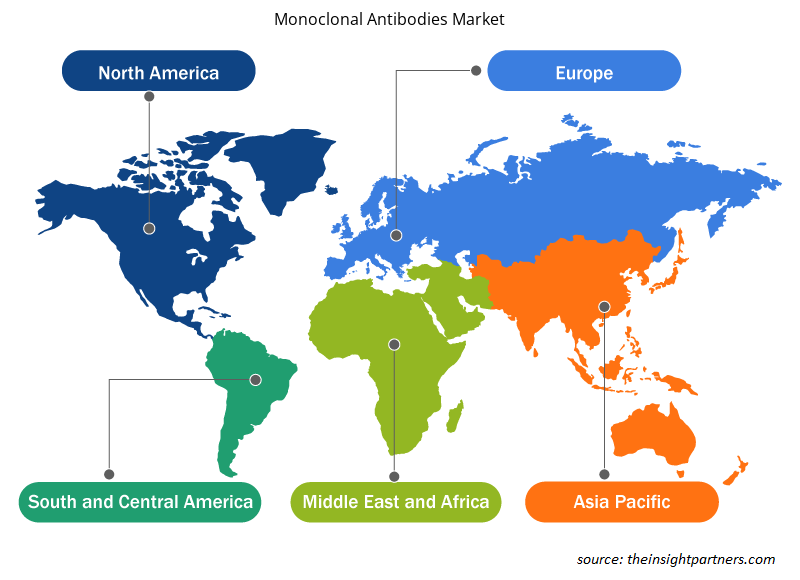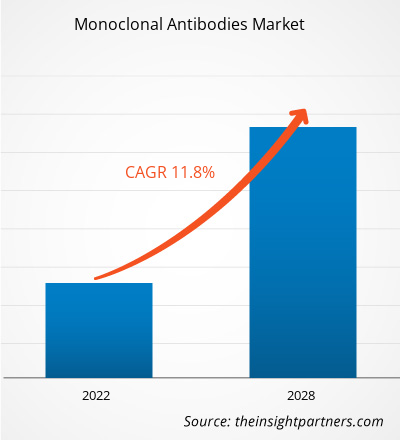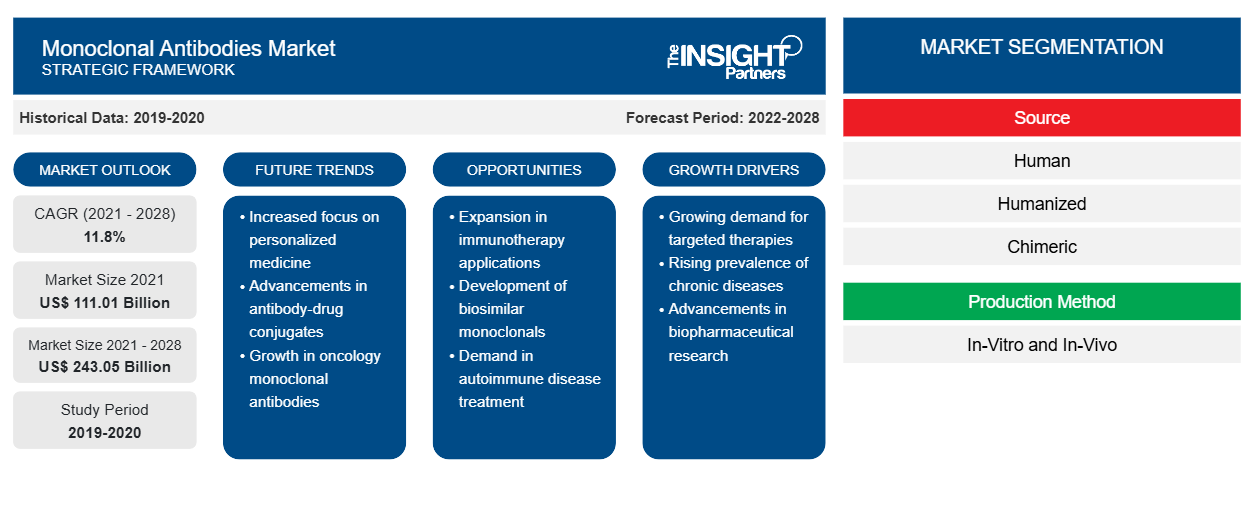Der Markt für monoklonale Antikörper soll von 111,01 Milliarden US-Dollar im Jahr 2021 auf 243,05 Milliarden US-Dollar im Jahr 2028 anwachsen; von 2021 bis 2028 dürfte er voraussichtlich mit einer durchschnittlichen jährlichen Wachstumsrate von 11,8 % wachsen.
Die zunehmende Verbreitung von Krebs und anderen chronischen Krankheiten sowie ein enormer Anstieg der COVID-19-Fälle in verschiedenen Regionen sind die Hauptfaktoren, die das Marktwachstum ankurbeln. Laut World Cancer Research Fund und American Institute for Cancer wurden im Jahr 2020 etwa 18,1 Millionen Krebsfälle registriert, darunter 9,3 Millionen Fälle bei Männern und 8,8 Millionen Fälle bei Frauen. Der Einsatz monoklonaler Antikörper bei der Behandlung verschiedener Krebsarten befindet sich noch in den Studien der Phasen 2 und 3.
Nordamerika wird seine Vorherrschaft auf dem Markt für monoklonale Antikörper voraussichtlich zwischen 2021 und 2028 beibehalten. Die USA halten den größten Marktanteil in dieser Region und werden voraussichtlich auch im Prognosezeitraum ein dominanter Anteilseigner auf dem Markt bleiben. Laut den von Globocan 2020 veröffentlichten Statistiken wurden in den USA ~1.806.590 neue Krebsfälle diagnostiziert und ~606.520 Menschen starben an dieser Krankheit. Laut einem Bericht des US-Handelsministeriums kündigte dessen National Institute of Standards and Technology (NIST) die Finanzierung des National Institute for Innovation in Manufacturing Biopharmaceuticals in Höhe von 153 Millionen US-Dollar an. Darüber hinaus hat die FDA ihre Unterstützung für die Entwicklung monoklonaler Antikörper während der COVID-19-Prävalenz ausgeweitet.
Passen Sie diesen Bericht Ihren Anforderungen an
Sie erhalten kostenlos individuelle Anpassungen an jedem Bericht, einschließlich Teilen dieses Berichts oder einer Analyse auf Länderebene, eines Excel-Datenpakets sowie tolle Angebote und Rabatte für Start-ups und Universitäten.
- Holen Sie sich die wichtigsten Markttrends aus diesem Bericht.Dieses KOSTENLOSE Beispiel umfasst eine Datenanalyse von Markttrends bis hin zu Schätzungen und Prognosen.
Markteinblicke
Deutlicher Anstieg der Krebs- und anderen chronischen Erkrankungen treibt Marktwachstum an
Laut dem Bericht der American Cancer Society lebten im Januar 2019 etwa 16,9 Millionen Menschen mit einer Krebsvorgeschichte in den USA. Bis Januar 2030 dürfte die Zahl der Krebsüberlebenden allein aufgrund des Wachstums und der Alterung der Bevölkerung auf 22,1 Millionen steigen. Mit der zunehmenden Verbreitung von Krebs und anderen chronischen Krankheiten ist daher auch die Nachfrage nach Biologika wie monoklonalen Antikörpern (mABs) stark gestiegen. Als Hauptbestandteile vieler Therapieschemata und kosteneffizienter Behandlungen spielen Biologika eine Schlüsselrolle bei der Krebsbehandlung.
Quellenbasierte Erkenntnisse
Basierend auf der Quelle ist der Markt für monoklonale Antikörper in murine, chimäre, humane und humanisierte Antikörper segmentiert. Das humane Segment wird voraussichtlich zwischen 2021 und 2028 den größten Marktanteil ausmachen. Das Marktwachstum dieses Segments wird dem Anstieg aufgrund der Integration humaner monoklonaler Antikörper zur Behandlung verschiedener Arten von Infektionskrankheiten zugeschrieben . So brachte Regeneron beispielsweise den von der FDA zugelassenen Antikörpercocktail Casirivimab und Imdevimab zusammen zur Verwendung bei COVID-19 auf den Markt. Das Medikament hat von der FDA eine Notfallzulassung (EUA) erhalten. Es wird zur Behandlung von leichtem bis mittelschwerem COVID-19 bei Erwachsenen sowie bei pädiatrischen Patienten ab 12 Jahren und einem Gewicht von mindestens 40 kg verwendet. Darüber hinaus zählen eine zunehmende Verwendung bei verschiedenen chronischen Krankheiten und der Einsatz fortschrittlicher Gentechnik zu den wichtigen Faktoren, die das Wachstum dieses Marktsegmentes vorantreiben.
Indikationsbasierte Erkenntnisse
Je nach Indikation Krebs, Autoimmunerkrankungen, entzündliche Erkrankungen , Infektionskrankheiten, mikrobielle Erkrankungen und andere. Das Krebssegment wird den Markt in den kommenden Jahren dominieren. Fortschritte im Zusammenhang mit der therapeutischen Anwendung monoklonaler Antikörper haben ihren erfolgreichen Einsatz bei der Behandlung verschiedener Krebsarten wie Brustkrebs, Lungenkrebs und Dickdarmkrebs ermöglicht. Auf diesen Antikörpern basierende Medikamente helfen dabei, Krebszellen zu kennzeichnen, die Zerstörung der Zellmembran auszulösen, Inhibitoren des Immunsystems zu blockieren und so weiter. Die FDA hat im Juni 2020 zwei Medikamente – Olaparib und Rucaparib – zur Behandlung von Prostatakrebs zugelassen. Das Medikament ist besonders wirksam bei Männern mit Prostatakrebs, der sich ausgebreitet oder metastasiert hat und nicht mehr auf Standardhormonbehandlungen anspricht (d. h. bei kastrationsresistenter Erkrankung).
Endbenutzerbasierte Erkenntnisse
Nach Endverbraucher ist der Markt für monoklonale Antikörper in Krankenhäuser, Forschungsinstitute und andere unterteilt. Das Krankenhaussegment hält den größten Marktanteil aufgrund der zunehmenden Akzeptanz von mABs als bevorzugte Behandlungsmethode, insbesondere zur Krebsbehandlung.
Unternehmen, die auf dem Markt für monoklonale Antikörper tätig sind, verfolgen eine Produktinnovationsstrategie, um den sich entwickelnden Kundenanforderungen weltweit gerecht zu werden und gleichzeitig ihren Markennamen auf dem Weltmarkt zu behaupten.
Regionale Einblicke in den Markt für monoklonale Antikörper
Die regionalen Trends und Faktoren, die den Markt für monoklonale Antikörper im Prognosezeitraum beeinflussen, wurden von den Analysten von Insight Partners ausführlich erläutert. In diesem Abschnitt werden auch die Marktsegmente und die Geografie für monoklonale Antikörper in Nordamerika, Europa, im asiatisch-pazifischen Raum, im Nahen Osten und Afrika sowie in Süd- und Mittelamerika erörtert.

- Erhalten Sie regionale Daten zum Markt für monoklonale Antikörper
Umfang des Marktberichts zu monoklonalen Antikörpern
| Berichtsattribut | Details |
|---|---|
| Marktgröße im Jahr 2021 | 111,01 Milliarden US-Dollar |
| Marktgröße bis 2028 | 243,05 Milliarden US-Dollar |
| Globale CAGR (2021 - 2028) | 11,8 % |
| Historische Daten | 2019-2020 |
| Prognosezeitraum | 2022–2028 |
| Abgedeckte Segmente | Nach Quelle
|
| Abgedeckte Regionen und Länder | Nordamerika
|
| Marktführer und wichtige Unternehmensprofile |
|
Marktdichte monoklonaler Antikörper: Auswirkungen auf die Geschäftsdynamik verstehen
Der Markt für monoklonale Antikörper wächst rasant, angetrieben durch die steigende Nachfrage der Endnutzer aufgrund von Faktoren wie sich entwickelnden Verbraucherpräferenzen, technologischen Fortschritten und einem größeren Bewusstsein für die Vorteile des Produkts. Mit steigender Nachfrage erweitern Unternehmen ihr Angebot, entwickeln Innovationen, um die Bedürfnisse der Verbraucher zu erfüllen, und nutzen neue Trends, was das Marktwachstum weiter ankurbelt.
Die Marktteilnehmerdichte bezieht sich auf die Verteilung der Firmen oder Unternehmen, die in einem bestimmten Markt oder einer bestimmten Branche tätig sind. Sie gibt an, wie viele Wettbewerber (Marktteilnehmer) in einem bestimmten Marktraum im Verhältnis zu seiner Größe oder seinem gesamten Marktwert präsent sind.
Die wichtigsten auf dem Markt für monoklonale Antikörper tätigen Unternehmen sind:
- Novartis AG
- Pfizer Inc.
- GlaxoSmithKline plc
- Amgen, Inc
- Daiichi Sankyo Company, Limited
Haftungsausschluss : Die oben aufgeführten Unternehmen sind nicht in einer bestimmten Reihenfolge aufgeführt.

- Überblick über die wichtigsten Akteure auf dem Markt für monoklonale Antikörper
Markt für monoklonale Antikörper – Segmentierung
Basierend auf der Quelle ist der Markt für monoklonale Antikörper in humane, humanisierte, chimäre und murine Antikörper unterteilt. Nach der Produktionsmethode ist der Markt in In-vitro und In-vivo unterteilt. Der Markt für monoklonale Antikörper ist nach Indikation weiter unterteilt in Krebs, Autoimmunerkrankungen, Infektionskrankheiten, entzündliche Erkrankungen, mikrobielle Erkrankungen und andere. Nach Anwendung ist der Markt in therapeutische Anwendungen, diagnostische Anwendungen und Forschungsanwendungen unterteilt. Darüber hinaus ist der Markt nach Endbenutzer in Krankenhäuser, andere und Forschungsinstitute unterteilt.
Markt für monoklonale Antikörper – nach Geografie
- Nordamerika
- UNS
- Kanada
- Mexiko
- Europa
- Frankreich
- Deutschland
- Italien
- Vereinigtes Königreich
- Spanien
- Restliches Europa
- Asien-Pazifik (APAC)
- China
- Indien
- Südkorea
- Japan
- Australien
- Restlicher Asien-Pazifik-Raum
- Naher Osten und Afrika (MEA)
- Südafrika
- Saudi-Arabien
- Vereinigte Arabische Emirate
- Rest von MEA
- Süd- und Mittelamerika (SCAM)
- Brasilien
- Argentinien
- Rest von SCAM
Firmenprofile
- Novartis AG
- Pfizer Inc.
- GlaxoSmithKline plc
- Amgen, Inc
- Daiichi Sankyo Company, Limited
- F. Hoffmann-La Roche AG
- AstraZeneca
- Elli Lily und Company
- Bayer AG
- Bristol-Myers Squibb Company
- Historische Analyse (2 Jahre), Basisjahr, Prognose (7 Jahre) mit CAGR
- PEST- und SWOT-Analyse
- Marktgröße Wert/Volumen – Global, Regional, Land
- Branchen- und Wettbewerbslandschaft
- Excel-Datensatz
Aktuelle Berichte
Erfahrungsberichte
Grund zum Kauf
- Fundierte Entscheidungsfindung
- Marktdynamik verstehen
- Wettbewerbsanalyse
- Kundeneinblicke
- Marktprognosen
- Risikominimierung
- Strategische Planung
- Investitionsbegründung
- Identifizierung neuer Märkte
- Verbesserung von Marketingstrategien
- Steigerung der Betriebseffizienz
- Anpassung an regulatorische Trends





















 Kostenlose Probe anfordern für - Markt für monoklonale Antikörper
Kostenlose Probe anfordern für - Markt für monoklonale Antikörper